Rating index:
Extraordinary (96-100)
Outstanding (93-95)
Very good to Excellent (89-92)
Above average to Good (86-88)
Below Average to Average (80-85)
Avoid (below 80)
More info >
Extraordinary (96-100)
Outstanding (93-95)
Very good to Excellent (89-92)
Above average to Good (86-88)
Below Average to Average (80-85)
Avoid (below 80)
More info >
"I often feel as though things take place of their own accord, and that the only thing I do is fine-tune a process that was already happening anyway (...)", Magnus Nilsson (b. 1983) writes in the Introduction to his book "Fäviken" (Phaidon, 2012). Here is a modest but a solid claim from the man who is executive chef at restaurant Fäviken Magasinet near Järpen in the middle of Sweden. When you think about it, the creation and ascent to world fame of Fäviken is an unlikely story (although perhaps not as strange as the story of the huge cow licking a on block of ice in Ginnungagap) and during the long drive back to Trondheim airport on the morning after my visit, I couldn't help but wonder whether destiny here had been a matter of chance or a matter of choice.
To take Fäviken to where it is today, has certainly required (personal) choices from a number of people and not in the least (but not only) from Magnus Nilsson himself. The 20,000 acre Fäviken farm and hunting estate can trace its origins back for centuries (the building which houses the restaurant was erected in 1745) but its modern history starts with the acquisition in 2003 by Patrik and Ann-Charlotte Brummer, who set about restoring it and thereby rescuing its cultural heritage. There had been a restaurant on the estate since the 1980's, focusing mainly on moose fondue dinners for corporate groups of up to 120 people, but the Brummer's weren't happy with the direction the restaurant was taking. It wasn't up to their standards and business wasn't very good either; its catchment area is, after all, very thinly populated.
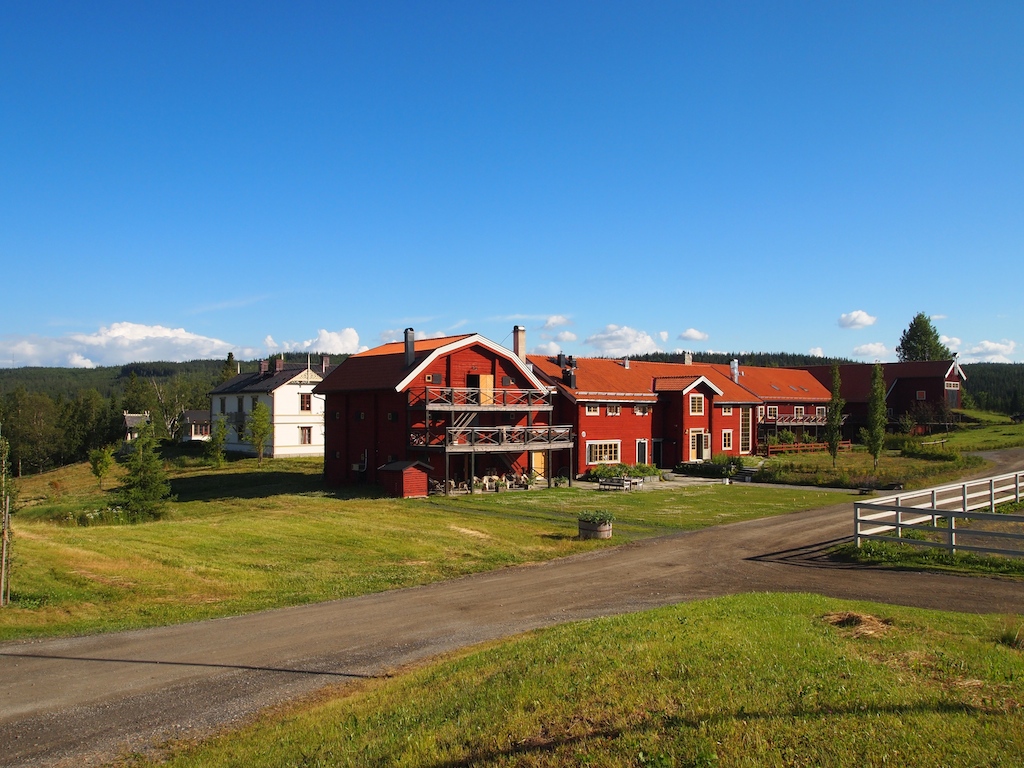
It was by chance that Magnus Nilsson came to Fäviken in 2008. Born in northern Sweden, he had known that he wanted to be a chef from a very early age and when he was 13 years old, he convinced his parents to send him to a boarding school for chefs in Åre (in the municipality of Järpen). After finishing school, he continued his training in the south of Sweden at restaurant Kattegat in the Skåne region and later on at Pontus in the Greenhouse in Stockholm (both now defunct). He then moved to Paris to work in the kitchens of Pascal Barbot's Astrance, during its rise to three Michelin stars.
After a few years however, he wanted to go back to Sweden and he took over the kitchen of a restaurant in Stockholm, cooking a similar style of food to that at Astrance. However, he was unable to find the quality of produce and the inspiration he was looking for and decided on a career change. He set his eyes on becoming a Master of Wine and a wine writer. Soon after, he received a phone call from an old friend then working at Fäviken, asking whether he would be interested in working in the restaurant (in front of house) for a few months, simultaneously building up the Brummer's private wine cellar.
When asked by Patrik Brummer what could be done to turn the restaurant into a high-quality, sustainable business, Nilsson essentially came up with the concept of what Fäviken is today. If you want to run an economically sound, top restaurant in a very remote area in Sweden just 200 miles south of the Arctic circle, you need people to want to travel there, not in spite of its location but because of it. This automatically involves using local produce, not for the sake of it, but because (i) it is the only way to get the quality necessary for what you want to do and (ii) because you can eat truffles, foie gras, lemons and Parmesan anywhere. Nothing religious about it.
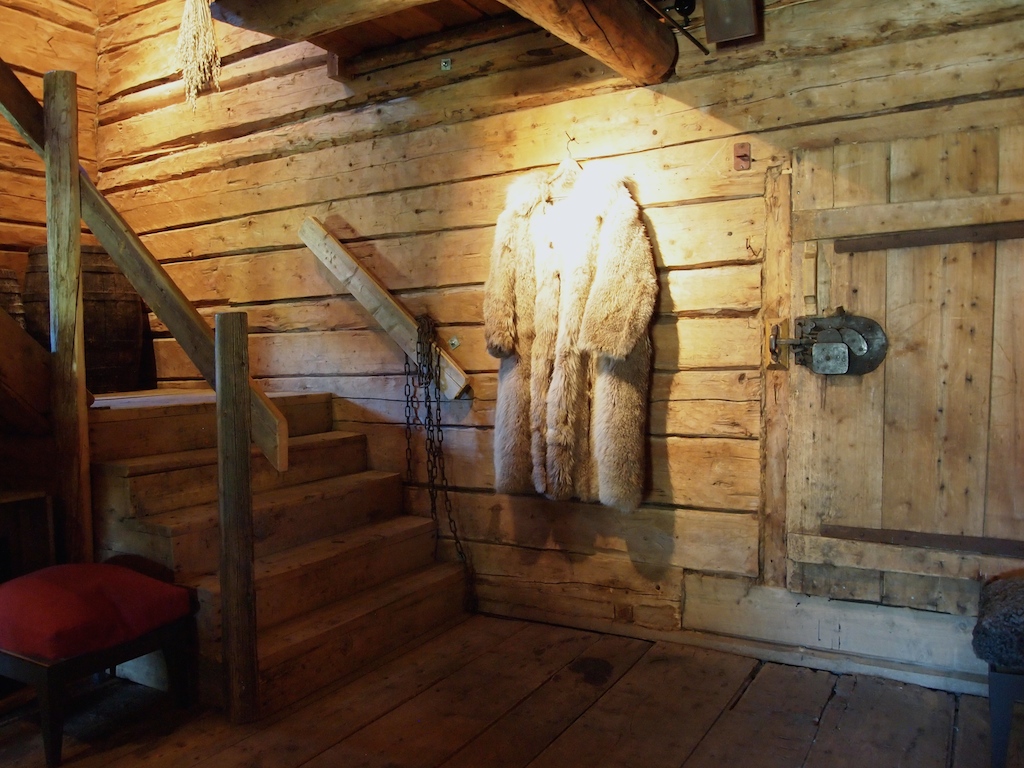
After all these chances and choices, Fäviken today is a 16-cover restaurant with 6 rooms. Each room features two single beds and a wash basin, but the shower and toilet facilities are communal. From Tuesday till Saturday the restaurant serves a multi-course seasonal tasting menu (dinner only), comprising around 13 courses plus appetisers and sweets for SEK 1,750 (£150) and overnight guests can enjoy breakfast the next morning. Fäviken currently occupies the number 19 spot in San Pellegrino's World's 50 Best Restaurants list.
I had dinner with my husband at Fäviken on Saturday 19 July 2014 and on that night a group of 11 had gathered for dinner, including a couple from Germany and three Americans. Dinner at Fäviken usually starts at 7.00pm sharp with drinks and appetisers in the bar area of the restaurant on the ground floor. On the night I was there, most of us were well on time so we kicked off a little bit early.
To start there were some delicate linseed crisps, served with a creamy mussel dip. A lovely flavour combination with some acidity in the aftertaste. Next up were Fäviken's signature crisp-textured pig's blood croustades filled with a pig's blood custard and topped with shiny wild trout roe. A wonderfully texturial dish with a fantastic combination of flavours, the roe delivering a lovely touch of juicy saltiness.
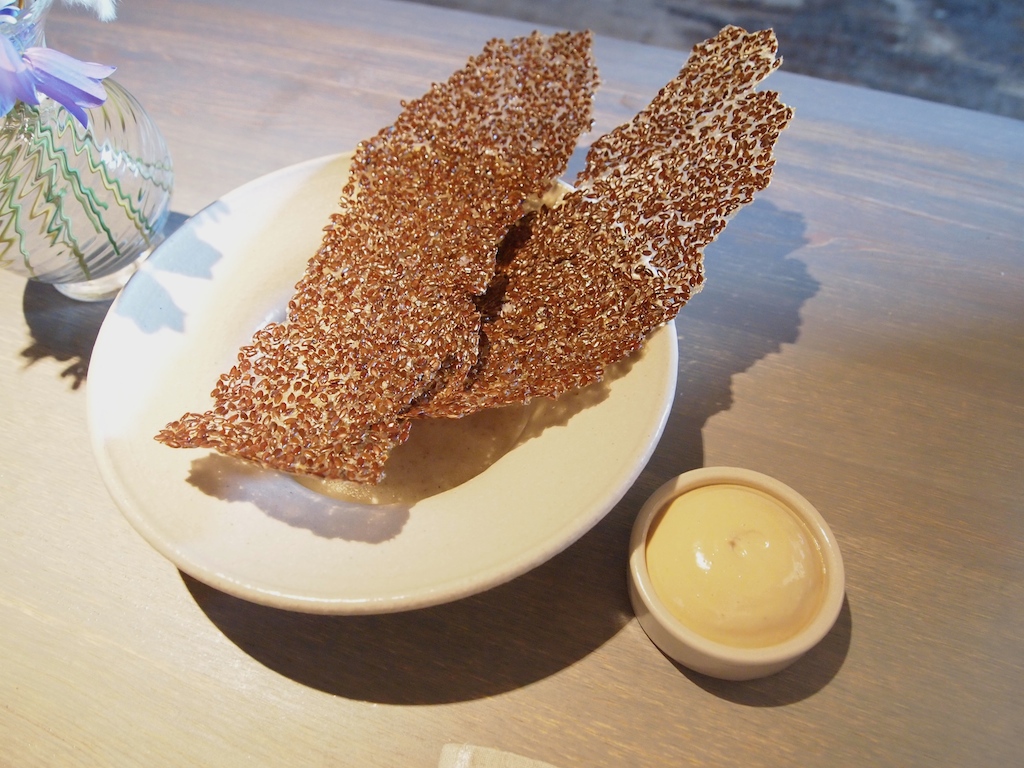
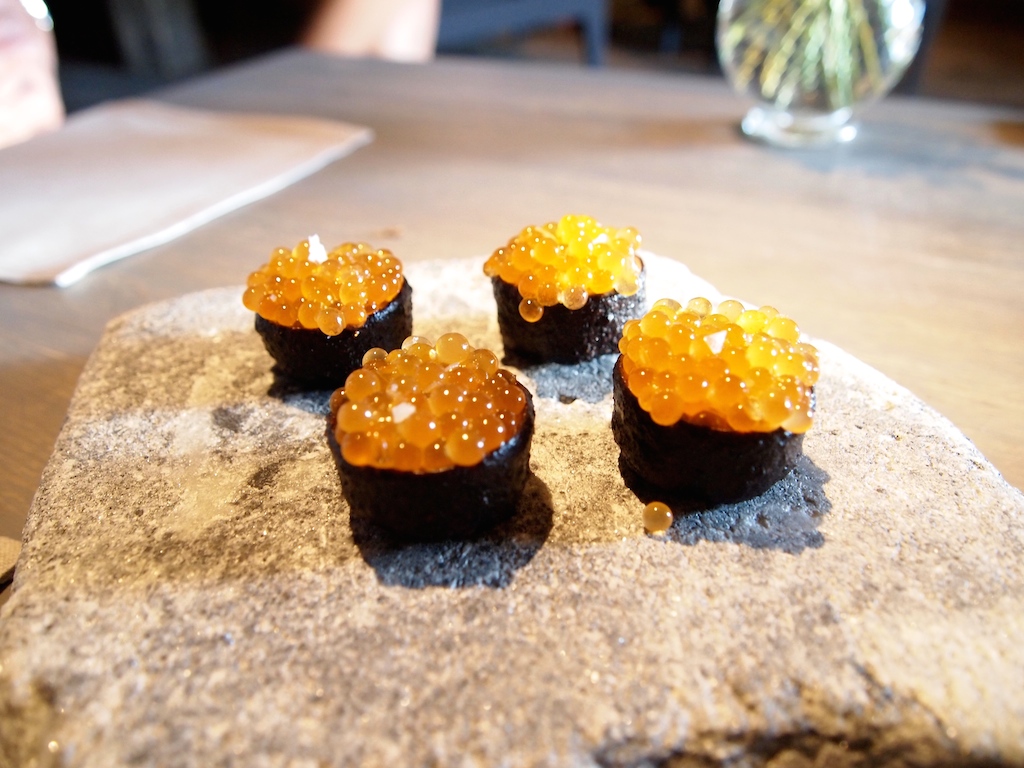
Pig's head in sourdough followed. A soft mixture of braised pig's head is dipped in sourdough, then deep-fried, and garnished with a piece of raw rhubarb and some tarragon salt. A very pleasing combination and nice to see something as humble as pig's head, turned into something as delicious and creative as this, with great flavour and texture. Then there was a beautifully presented dish of thin slices of salted herring (aged for 3 years) served with sour cream on rusks (crisp biscuits). The lovely, rich and meaty herring had an intense saltiness, a bit like anchovy but more refined. Last to arrive were some thin slices of tasty cured and air-dried pork (sow) sausage from a local charcuterie producer in Undersåker. A traditional Swedish Congnacsmedwurst from the same producer had been served earlier with our aperitifs.

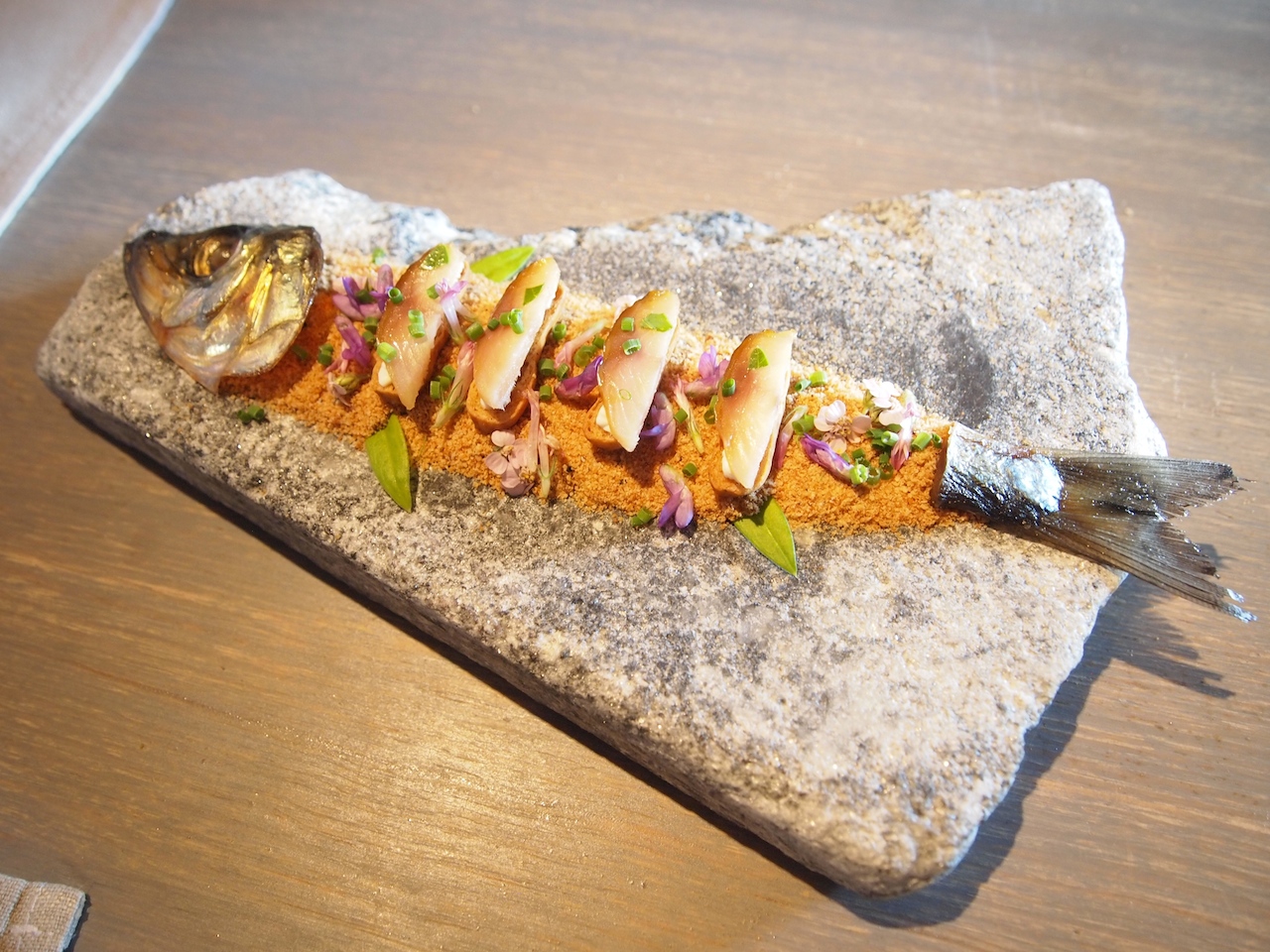

Â
After the final appetiser had been served, we were invited upstairs to the restaurant's intimate and welcoming dining room, a minimalist but cosy room with a wooden decor. Shortly after having been seated we were served some home-baked wheat sourdough, made with local wheat and served with soft butter, made from milk from a local dairy farm.The first course of the menu was Scallop "i skalet ur elden" (ye shall watch the fire), another signature dish that has been on the menu for years, and which is intended to be eaten with your hands. The scallop (from Hitra, just outside Trondheim in Norway) is briefly cooked in its still closed shell over a fire of juniper branches and birch charcoal. After that the complete content (including the juices) is taken from the shell and placed in a warm bowl. The white muscle meat is then, together with the juices, placed back into the shell and served on a bed of moss and juniper branches, accompanied by a piece of birch charcoal. When I removed the top shell there was this gigantic, juicy scallop, perfectly cooked, and full with sweet, briny and mildly earthy flavours; eating the scallop with your hands intensified the flavour experience. More scallop goodness came from the juices, that had a lovely touch of smokiness and which were meant to be drunk straight from the shell.
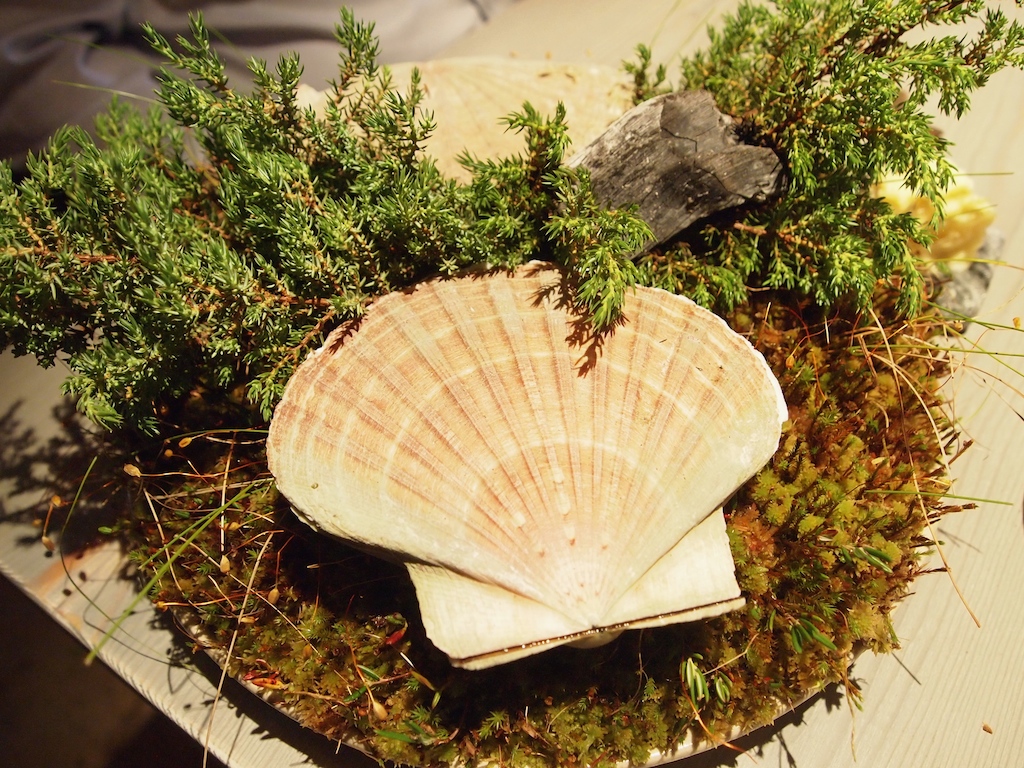
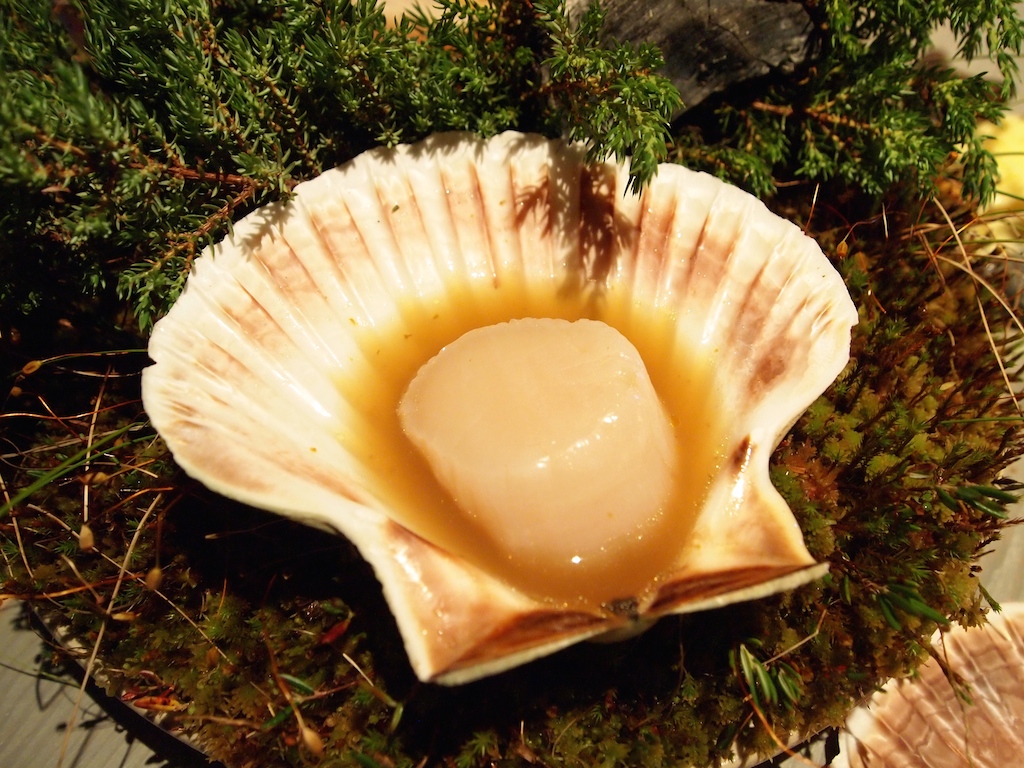
Kind crab and 'almost burnt cream' followed. An absolutely stunning piece of Norwegian king crab, bursting with its natural sweet juices. The king crab is quickly seared in a very hot pan and then simply seasoned with a spray of ättika vinegar (a very strong and pungent white vinegar with a formidable acidity level of up to 24%). The burnt cream (reduced until almost burnt) had a clotted cream-like thickness and wonderful, caramelised, milk sugar flavours. An unadulterated dish made with just two ingredients, but with exceptionally big flavours.
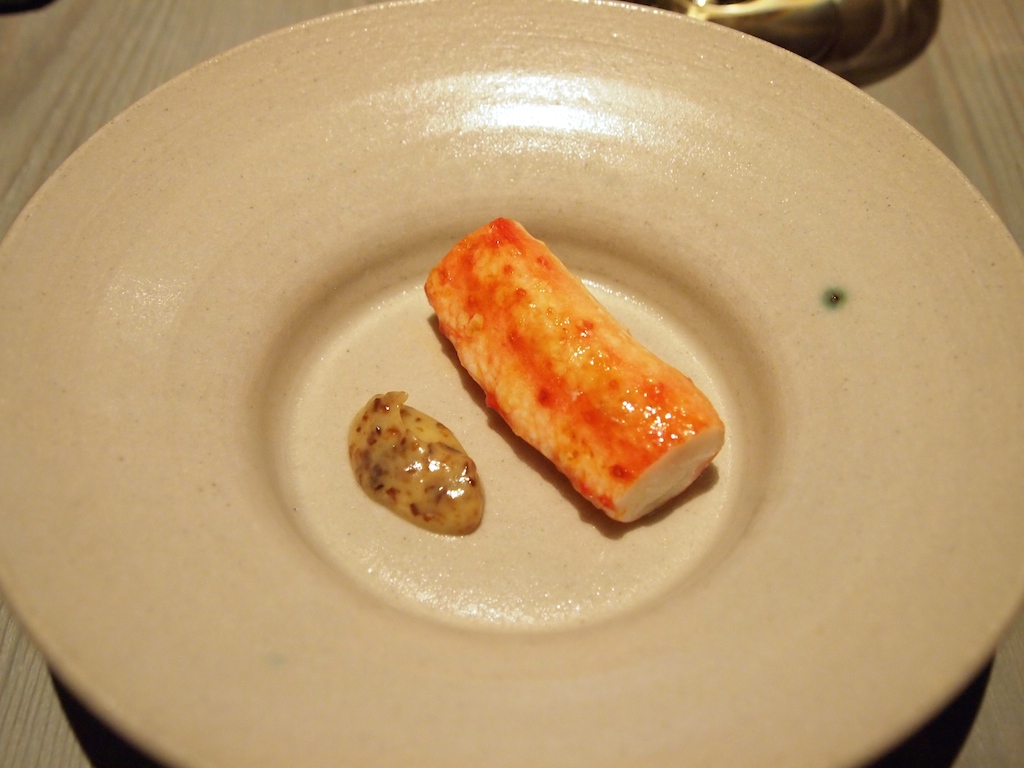
Next up was delicately poached brown trout (from the lake near the estate, line-caught by the restaurant staff) served with "bog butter" and lichen porridge. The doneness of the trout was impeccable, warm and moist but still slightly raw on the inside. Underneath the trout was some ättika vinegar jelly, chopped fireweed stems and lichen porridge: soft lichens with a creamy bechamel-like sauce made from the lichen cooking juices and wheat and sharpened with some vinegar. The 'ridge' of the trout had been elegantly decorated/seasoned with freshly picked herbs and crunchy fireweed, delivering extra texture and flavour.
But on to the butter. 'Bog butter' is butter that has been buried (often in a wooden container) and preserved in a peat bog (wetland). This ancient refrigeration method, used among others in Scandinavia, Scotland and Ireland, is thought to be at least 2,000 years old and during its period underground, the butter acquires aromas and flavours from the bog the butter is kept in. This particular one had been buried in the bog near the lake were the trout was caught, and had been flavoured with fresh, seasonal leaves and plants, such as wild geraniums, cranberry leaves, forest violet, sorrel, moss and lichens. All this had resulted in a pungent and creamy butter with lovely vegetal notes. An extraordinary and original dish with distinctive flavours and delicately balanced acidity. Incorporating a relatively mysterious/obscure ingredient such as bog butter is a great, inventive touch.
.jpg)
The meal continued with cockles injected with beer, transforming them into the juiciest cockles I have ever tasted. Alongside this came barley pancakes with a deliciously creamy filling of sour onions cooked in yoghurt whey.
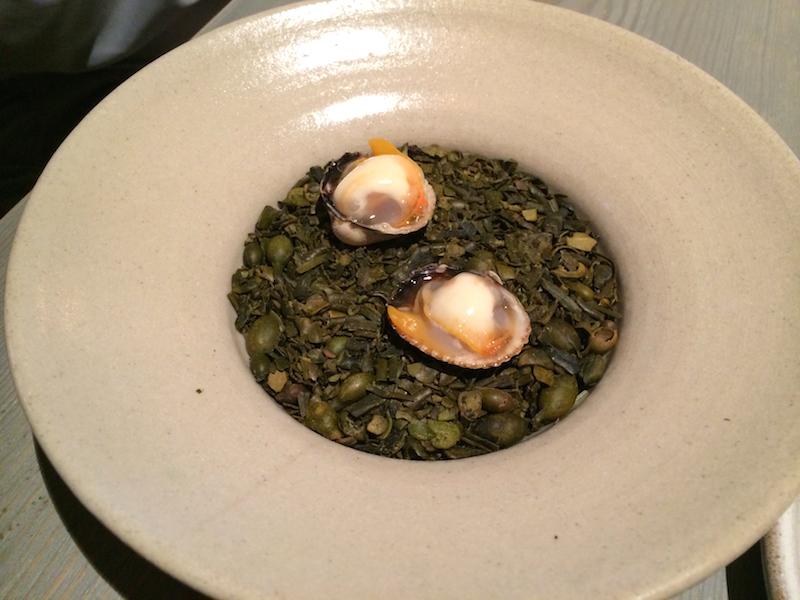
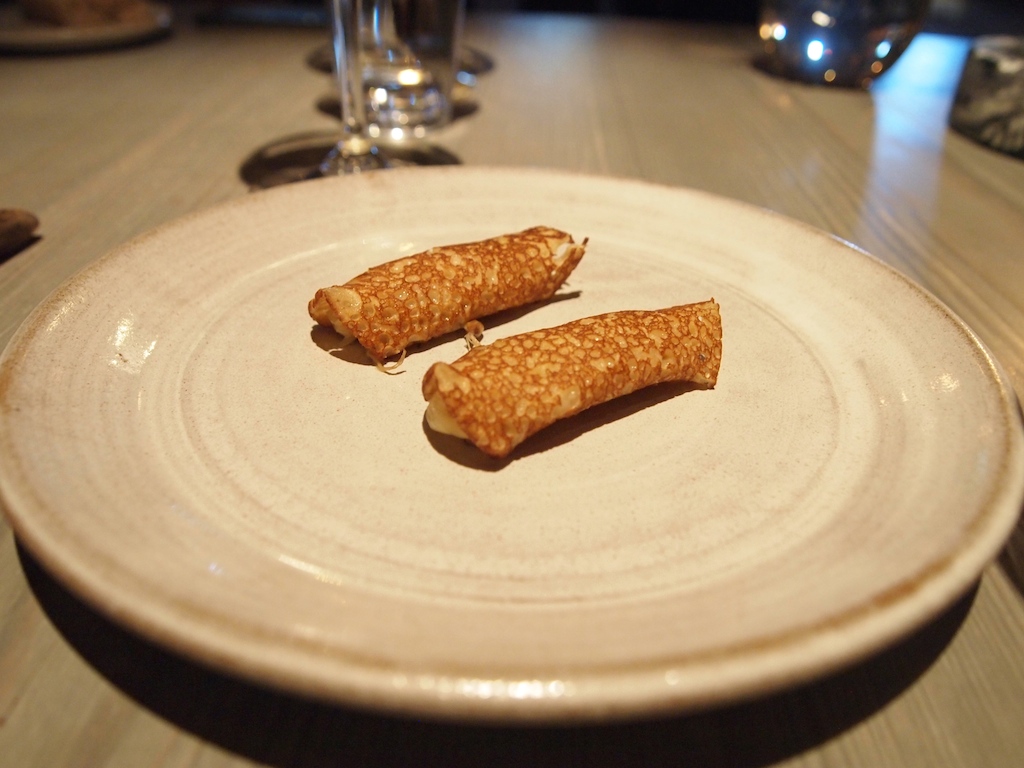
The sixth course was an enthralling dish of a soft-boiled quail's egg coated/marinated in a thin layer of sheep's dung ash. As we were told this is an old Icelandic dry-curing technique. The egg comes with a pickled marigold emulsion sprinkled with small pieces of dried, mildly smoky trout, which can be used for dipping after the shell of sheep's dung ash has been peeled off. When I first heard about this dish on social media, I found it rather off-putting. Why on earth would I voluntarily eat sheep's dung? But I was pleasantly surprised by the story and the attractive flavours of this dish.
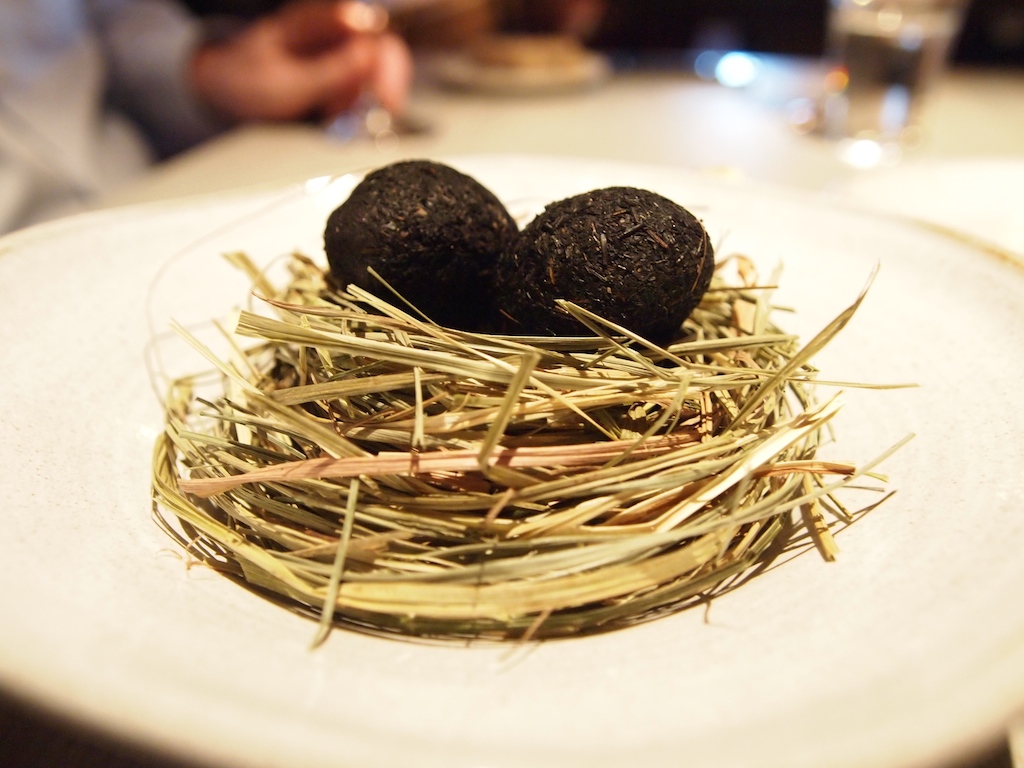
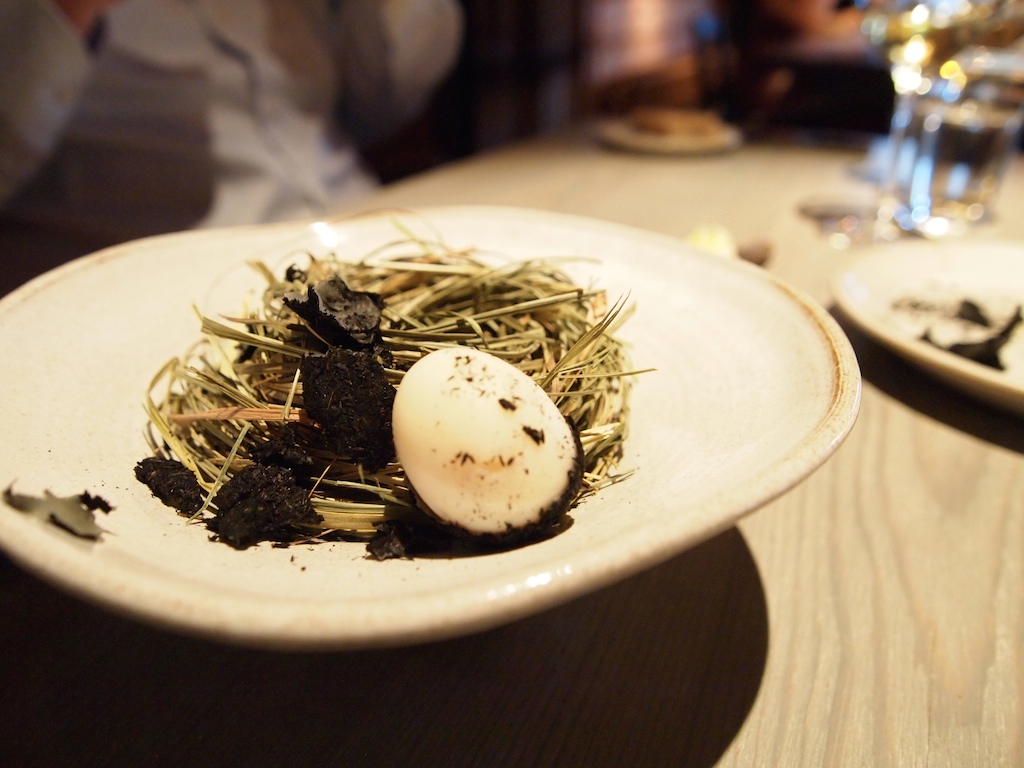

This was followed by Cottage cheese pie. A perfectly made pastry cup prepared with equal parts of butter and lard, that had a wonderful, delicate crispness to it. It was filled with a lovely fresh-tasting cottage cream and topped with a selection of fresh meadow flowers, wild plantain leaves and a fantastic pesto made from plantain leaves, pine nuts, breadcrumbs and some garlic. An elegant dish with light and delicate flavours, the pesto adding a nice zing to the dish.
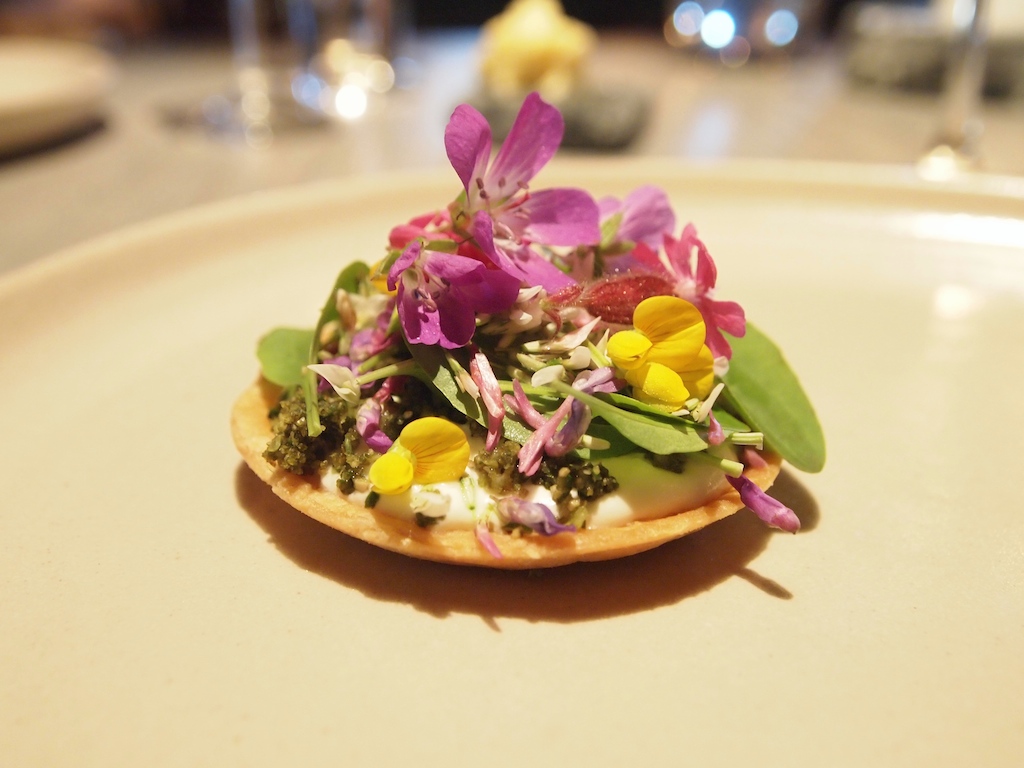
On to the seventh course, Blood bread served with moose broth, onion cream, burnt onions and chopped back fat. The bread is literally made with moose blood (instead of water) and lightly seasoned with fennel and caraway seeds. After the bread has been baked, it's dried and kept until needed. Right before serving the bread is braised in broth, resulting in a moist, bouncy texture, similar to that of a steamed bread dumpling. Really hefty flavours from the bread, soothed somewhat by the broth and the light onion cream, but it was still best to take little bites. A powerful dish with unconventional, contrasting flavours that, oddly enough, seemed to work.
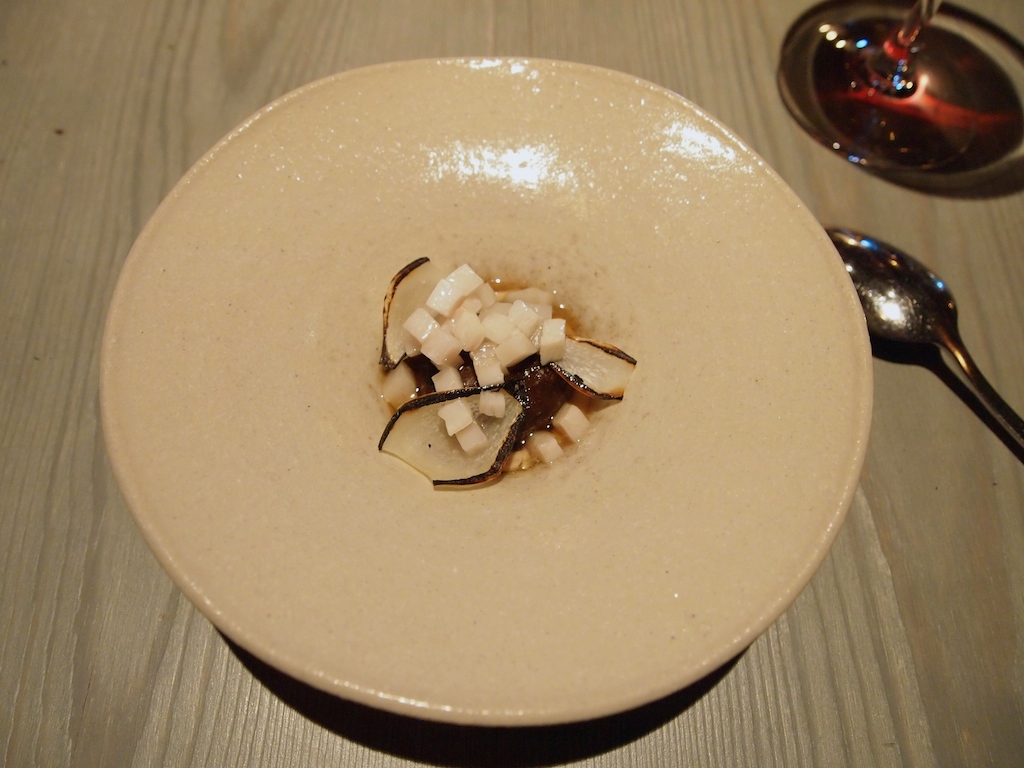
Then there was pork from Fäviken's main pork supplier, who also produces the pork (Svensk Lantras breed) used for the charcuterie! A rack of pork loin is pan-fried and rested on the grill. The whole rack had been presented to us earlier, just before the brown trout was served. Beautifully moist and succulent pork with a gorgeous layer of fat, that delivered a nice intense richness. The pork was accompanied by large chard leaf, simply seasoned with lovage salt, a light and elegant sauce of pork and chard juices and a spectacular, intensely flavoured 'tasty paste', an extreme reduction (10x) of a mixture of vegetables (carrots, shallots, mushrooms, onions) and beef stock, that has been fermented with yeast. A brilliantly restrained combination, allowing the pork to shine in all its glory.
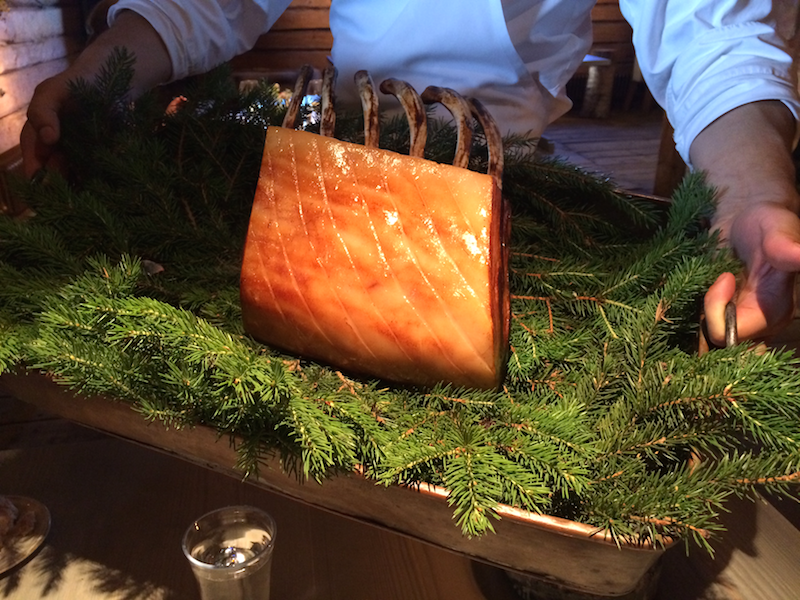
.jpg)
Shortly after the pork the first of the desserts was served. An edible crisp milk shell filled with creamy colostrum (the first milk produced after an animal has given birth) and blueberry jam. This was quickly followed by smooth blueberry ice and lingonberries, thick cream and sugar, served on wooden spoons. Three elegant and refreshing bites. Equally lovely was a warm, mildly creamy, curdled woodruff milk, served with yoghurt ice cream, creating a lovely temperature contrast and I liked the sweet-herbal notes from the woodruff.
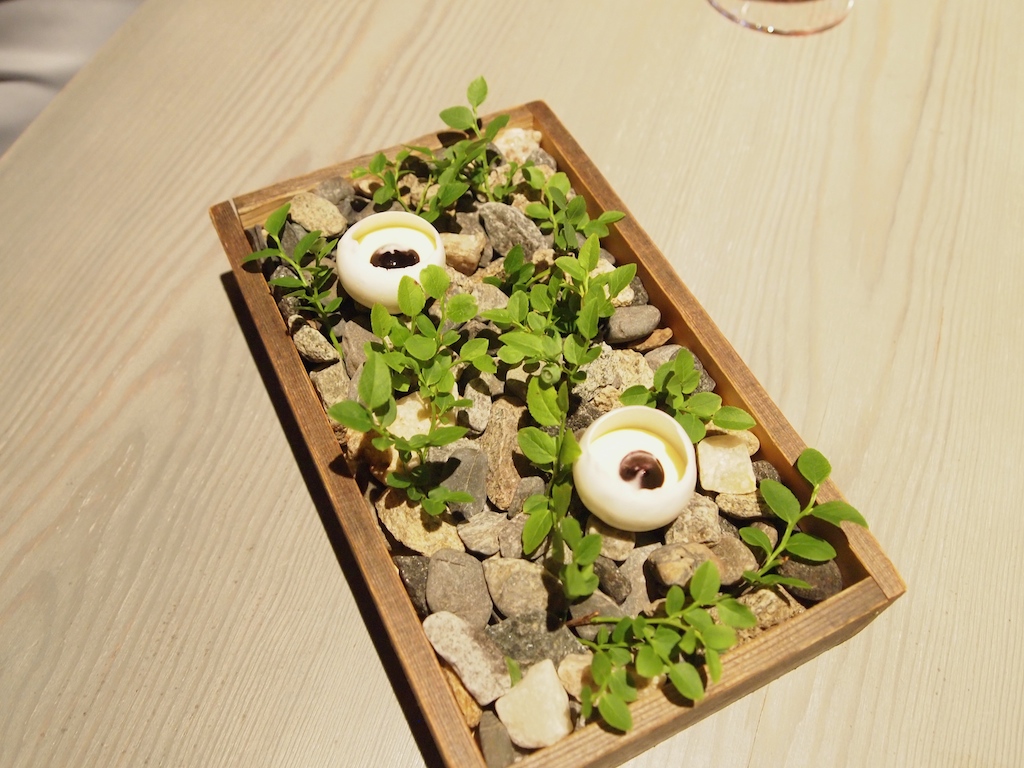
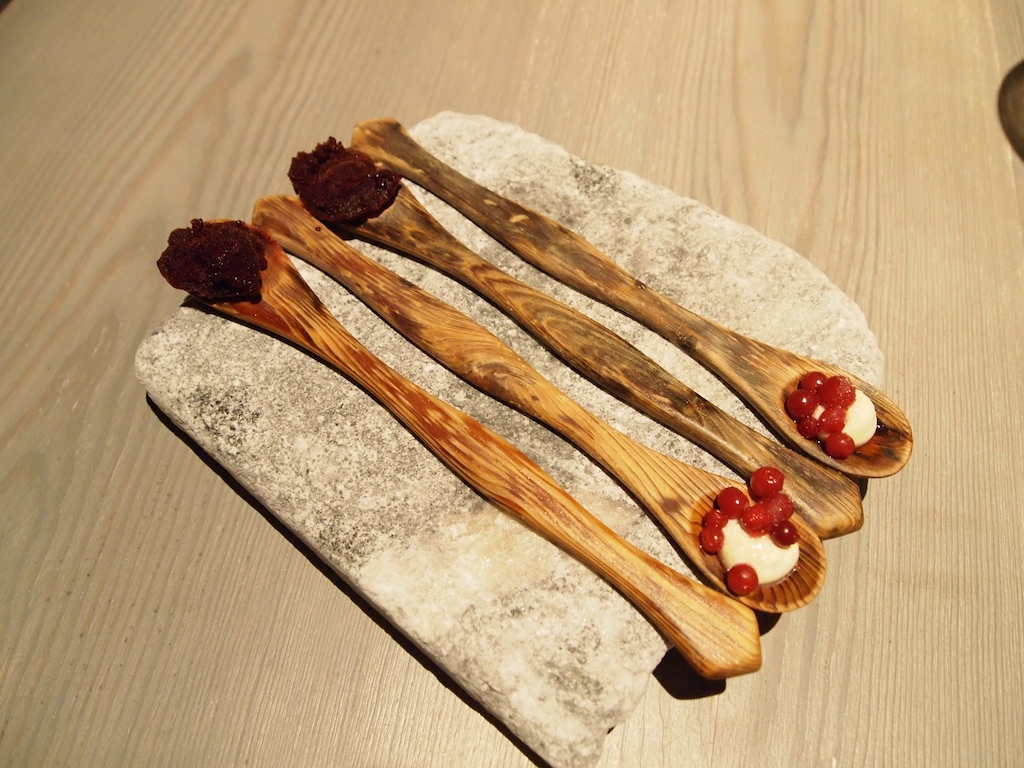
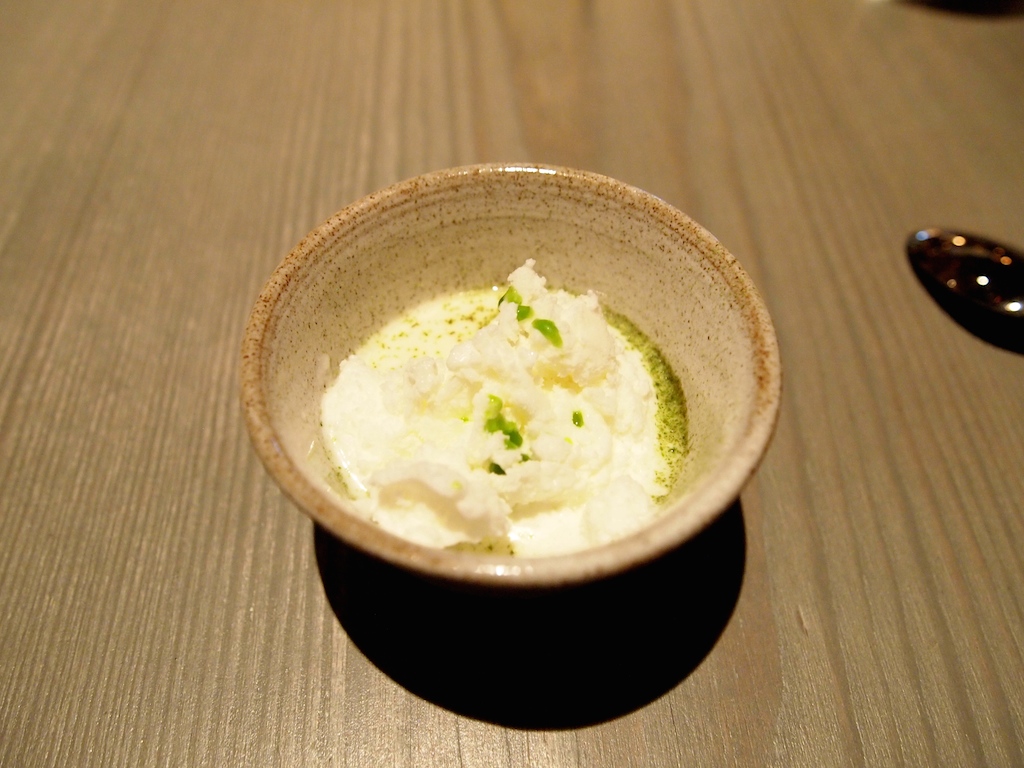
The next dessert had some more complexity to it. Egg yolk, preserved in sugar syrup, producing a yolk with a hard outer layer and a liquid centre. The yolk was served on a pile of deep-brown and crunchy pine tree bark cake crumbs. The restaurant doesn't use the actual bark for this cake, but they use a flour made from the phloem, a thin layer between the bark and the wood proper. An excellent and inspired combination, lovely mild sweetness from the egg yolk and pleasant, toasty sweetness and a light bitterness from the bark crumbs. Best of all was a side dish of creamy and soft ice cream with a 'well' of spruce syrup that had lovely bittersweet and fruity flavours.
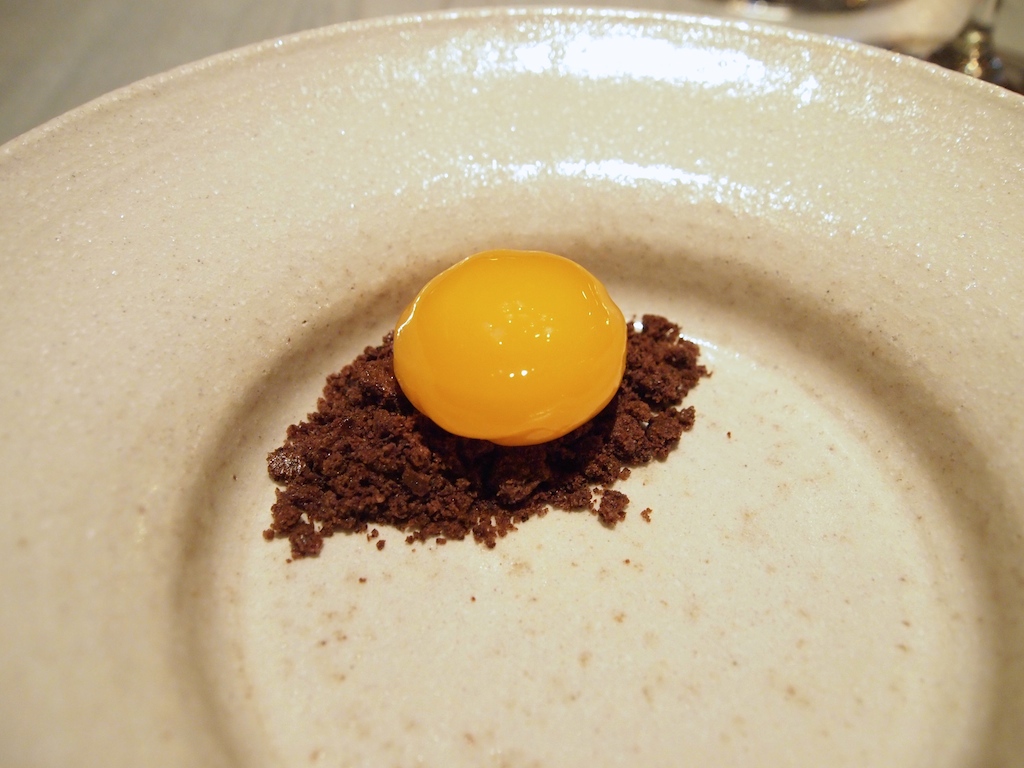

Â
The final dessert was a delicious sour milk sorbet (freshly churned in the dining room with a 100-year-old ice cream maker) and a pale and foamy whipped duck egg, with some marinated raspberries and raspberry puree hidden underneath. An incredibly elegant dessert, ticking all my dessert boxes: there's creaminess, there's tartness and there's sweetness, all perfectly balanced and the duck egg added just the right touch of richness.
Â
Â
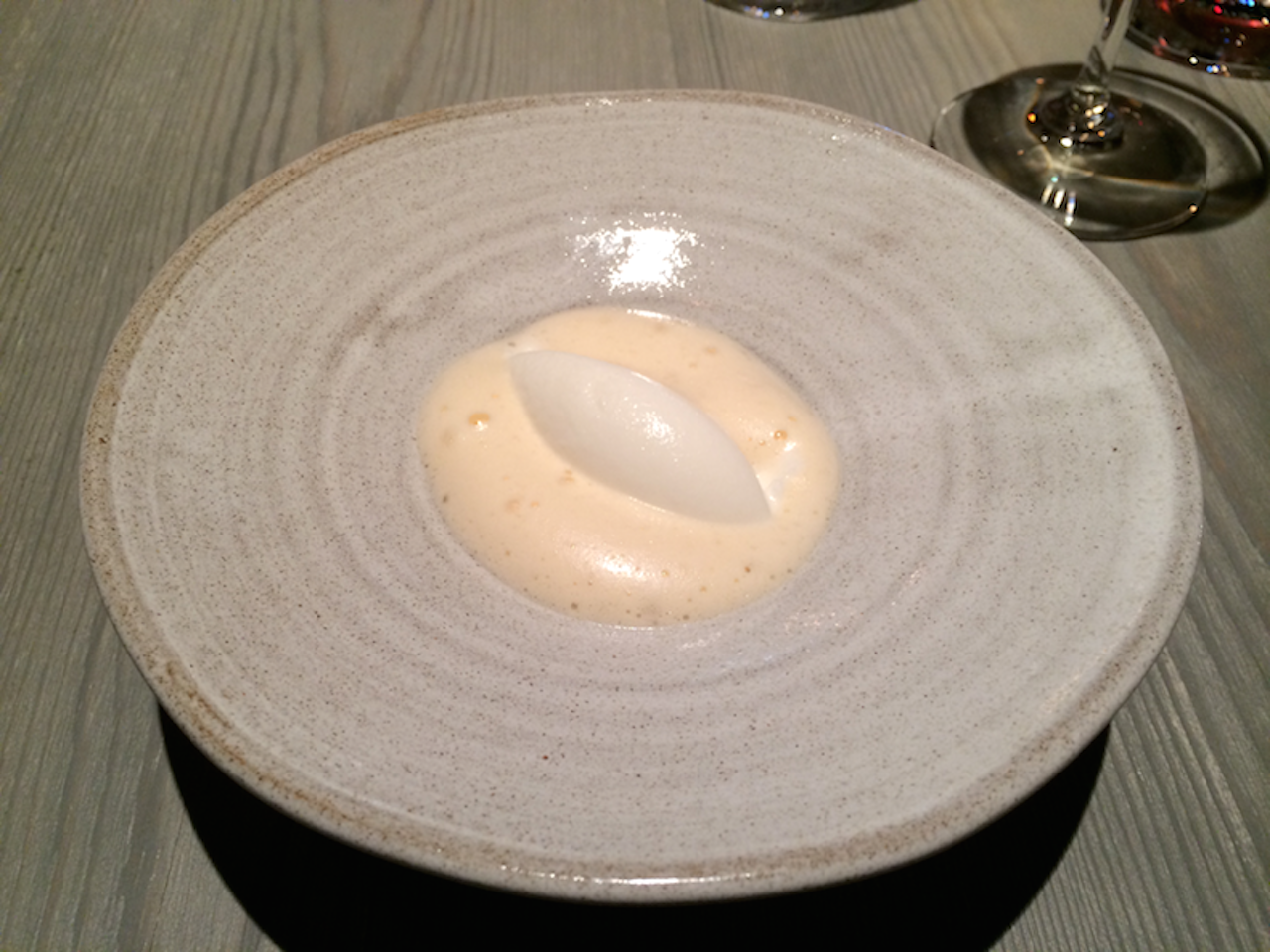
After the last dessert all of us went back downstairs to enjoy some coffee or tea infusions, homemade liqueurs, and a wooden box filled with marvellous (sweet and savoury) after dinner treats, such as raspberry ice, meadowsweet candy, dried berries, smoked toffees and meat pies with birch syrup and deer shavings.
Â
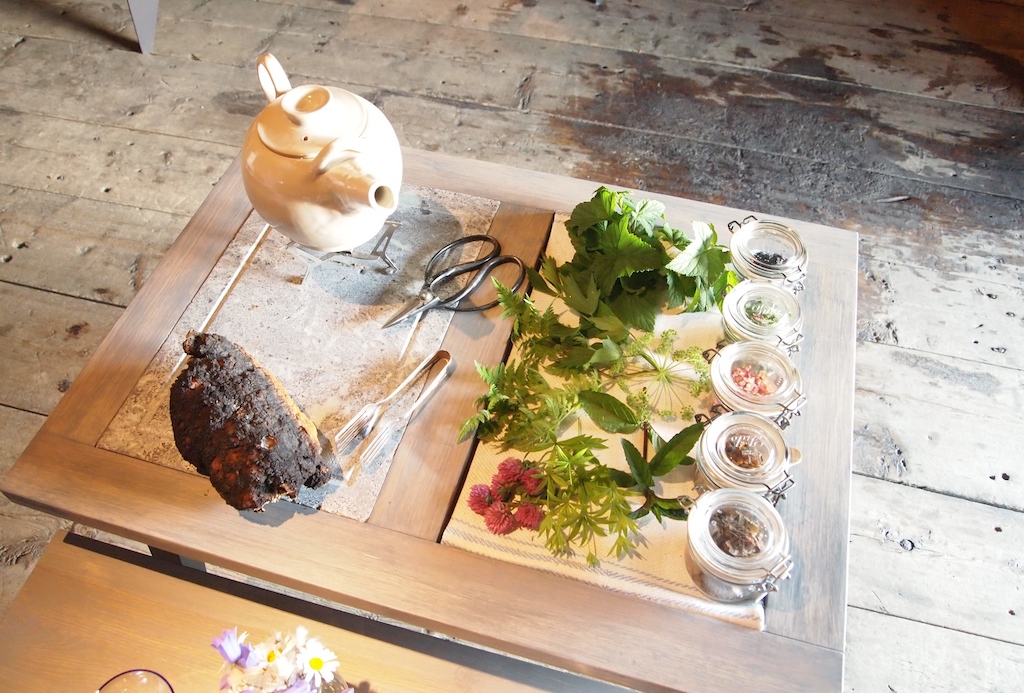
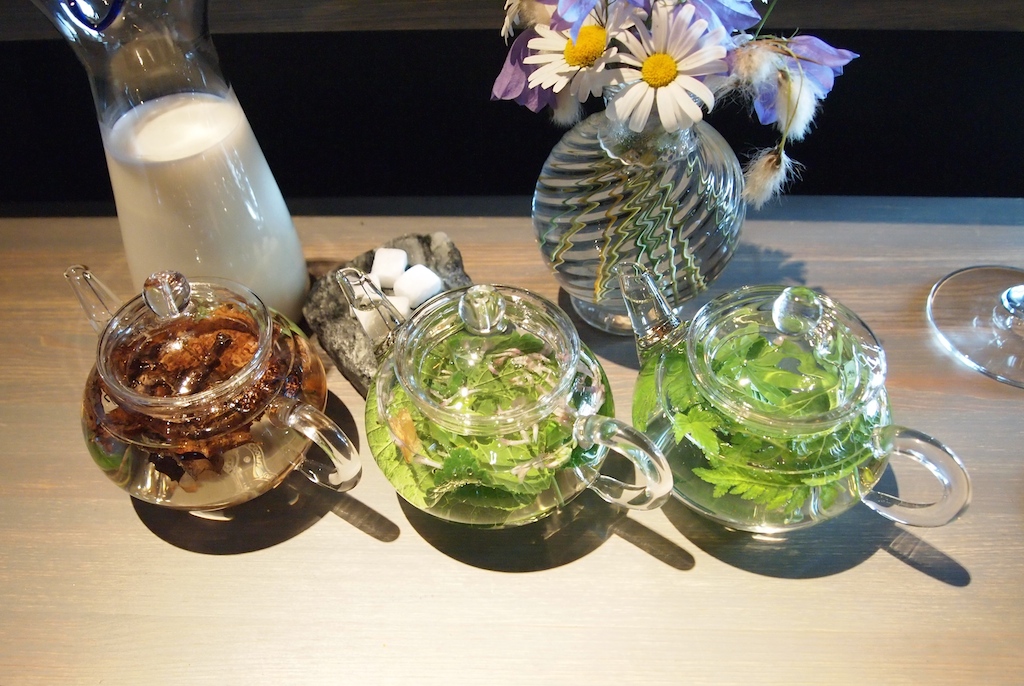
Tea infusions
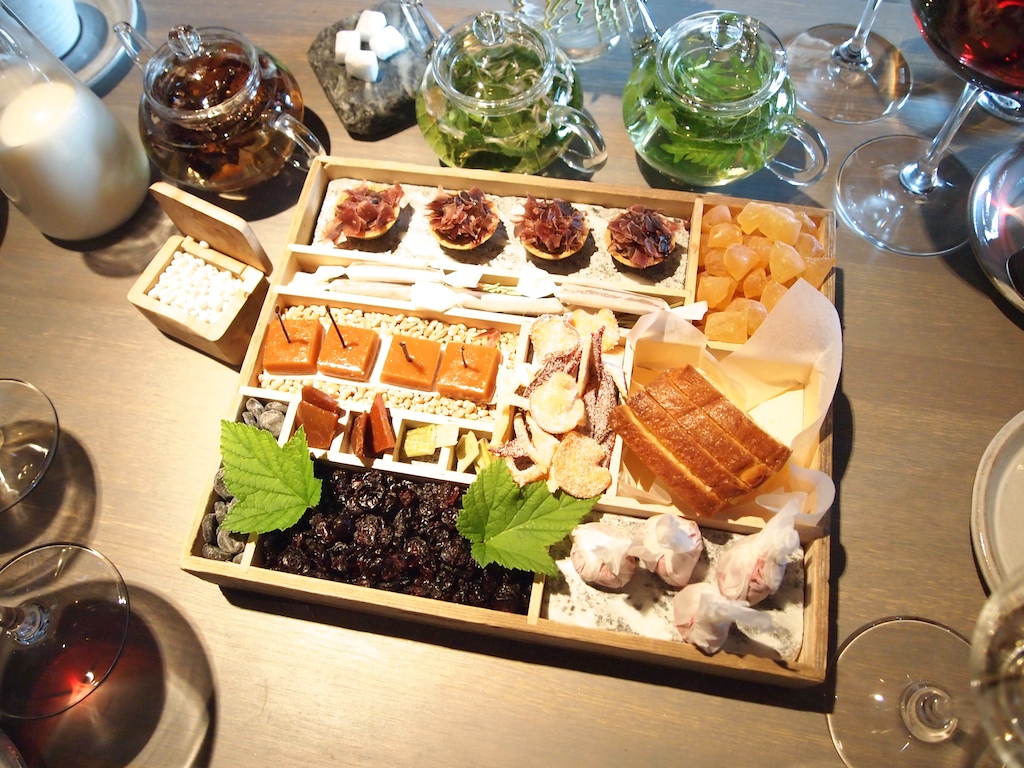
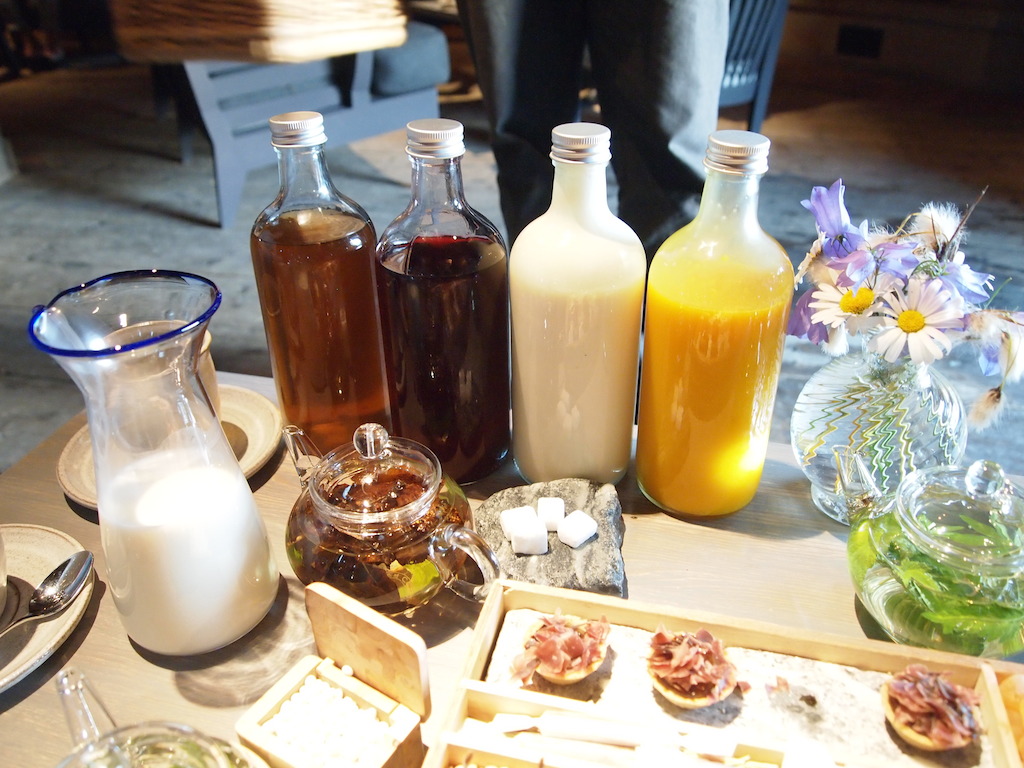
Homemade liqueurs like duck egg yolk, sour cream and blueberry
Â
"De dänne de e rektún mat de, mat at n kaer", Magnus Nilsson's grandfather used to exclaim when the food that grandma had cooked, pleased him. The scene made a lasting impression on young Magnus and "Rektún mat", real food, that it what Nilsson wants to cook and that is what Fäviken is all about. The deep emotional attachment which he has to the food he cooks, is also illustrated on a different level by the short story in his book about the butchering of the male lamb called Valdemar, from which he gained a new respect for the animal killed for food, as to him this animal was an individual he had come to know and like. So far North, food does not come in abundance and being frugal with what nature offers, is very much an integral element of Fäviken's ethics, philosophy and economics. There is a great sense of harmony about Fäviken, a harmony you can really feel when you are there. The food has a real sense of place and it tells an individual story - a story that takes you out of your comfort zone in a very pleasant way. There seems little point in pursuing a philosophy of localism and foraging when a restaurant is in an urban area, but it suits Fäviken like a glove.
I loved the mix of luxury and more humble ingredients in the well-designed menu and the pure flavours had real impact. What did surprise me, was the relative absence of vegetables in the meal - Nilsson describes his style of cooking as vegetable driven and I was there at the height of summer. His focus on local food heritage and traditional techniques (is this 'Old Nordic' cuisine?) does not mean that he shuns everything modern: they have a Pacojet in the kitchen and they put it to good use. I went to Fäviken with an open mind but also (I must admit) with a hint of scepticism. I was very pleased and impressed to find that with their practical and intuitive approach, Nilsson, head chef Jesper Karlsson, and their small kitchen team produce dishes that are without exception very attractive, both to the eye and on the palate. In fact I would go so far as to say that some dishes were a revelation.
The pace was excellent and the relaxed atmosphere in the intimate, cosy dining room allowed a personal, almost custom-made experience - the folk music in the background seemed very apt. The wine list is extensive and not unreasonably priced (but do not forget that this is Sweden and not Spain) and wine-wise too the approach is pragmatic: organic and bio-dynamic producers find favour here but natural wines are treated with a healthy realism by the excellent sommelier Robert Andersson. Fäviken is a place I really want to return to - preferably in winter. Time to start planning and saving up some pennies...
I loved the mix of luxury and more humble ingredients in the well-designed menu and the pure flavours had real impact. What did surprise me, was the relative absence of vegetables in the meal - Nilsson describes his style of cooking as vegetable driven and I was there at the height of summer. His focus on local food heritage and traditional techniques (is this 'Old Nordic' cuisine?) does not mean that he shuns everything modern: they have a Pacojet in the kitchen and they put it to good use. I went to Fäviken with an open mind but also (I must admit) with a hint of scepticism. I was very pleased and impressed to find that with their practical and intuitive approach, Nilsson, head chef Jesper Karlsson, and their small kitchen team produce dishes that are without exception very attractive, both to the eye and on the palate. In fact I would go so far as to say that some dishes were a revelation.
The pace was excellent and the relaxed atmosphere in the intimate, cosy dining room allowed a personal, almost custom-made experience - the folk music in the background seemed very apt. The wine list is extensive and not unreasonably priced (but do not forget that this is Sweden and not Spain) and wine-wise too the approach is pragmatic: organic and bio-dynamic producers find favour here but natural wines are treated with a healthy realism by the excellent sommelier Robert Andersson. Fäviken is a place I really want to return to - preferably in winter. Time to start planning and saving up some pennies...













